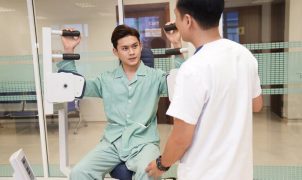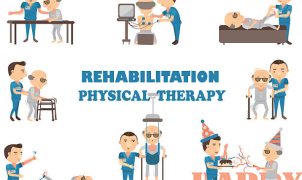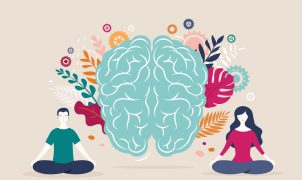Functional restoration and physical therapy are both specialized medical concepts that are often confused or thought to be the same. In reality, physical therapy is just a branch within the broader field of functional restoration. To better understand and differentiate between physical therapy and functional restoration, this article provides comprehensive information.
1. What is Functional Restoration?
Medical rehabilitation, or functional restoration, is a significant branch of medicine with three main responsibilities: disease prevention, treatment, and recovery. Functional restoration physicians may perform treatments independently or collaborate with other specialists, employing a combination of interventions such as surgery (orthopedics), medication (internal medicine), and various advanced techniques. In addition to traditional methods and patient-guided exercises, modern functional restoration utilizes cutting-edge medical equipment.
The significance and scope of functional restoration go beyond common perceptions. It involves a holistic approach to restore partial or full activity for individuals at risk of decreased abilities or disability. In cases of accidents or congenital disabilities, functional restoration extends to addressing social, economic, educational, and medical factors. The goal is to enable these individuals to lead normal, self-sufficient lives, integrate into communities, and eliminate societal stigma.

2. What is Physical Therapy?
Physical therapy is a specialized field within medical rehabilitation that helps patients regain mobility using physical agents (heat, water, electricity, ultrasound, laser, etc.) through exercises or equipment, including support devices. Physical therapy encompasses various functions and tasks:
- Examination and therapy to restore activity levels in disabled or impaired individuals.
- Treatment consultation for physical therapy in musculoskeletal disorders.
- Treatment consultation for physical therapy in obstetrics and gynecology.
- Treatment consultation for physical therapy in cardiovascular and respiratory disorders.
- Treatment consultation for physical therapy in neurological and musculoskeletal disorders.
- Treatment consultation for physical therapy in dermatological conditions (shingles, burns, scars, etc.).
A wide range of methods, from basic to modern, is applied in physical therapy, including electrotherapy, laser therapy, spinal traction, shockwave therapy, hyperbaric oxygen, and infrared light.
3. Differences between Functional Restoration and Physical Therapy
Functional restoration is a broader field that includes physical therapy. While physical therapy focuses on using physical factors to treat and improve physical conditions, functional restoration extends to psychological, educational, and societal aspects. Physical therapy primarily addresses issues related to physical health and movement, while functional restoration tackles complex problems associated with brain and nervous system functions, emotional well-being, and social integration.
Notably, the effectiveness of improving mood, cognition, and mental states is indirectly achieved through physical therapy. When physical injuries or health issues are addressed, resulting in reduced pain and stress, patients experience increased comfort and well-being. In contrast, functional restoration requires direct intervention by specialists and physicians to address neurological and emotional issues, contributing to positive patient outcomes.
4. Activities of Functional Restoration
Functional restoration activities are diverse and have preventive and therapeutic aspects, aiming to restore partial or complete functionality. Key activities include:
- Diagnosis and pain treatment to identify and determine the causes of body pain, whether physical trauma, internal organ damage, or symptoms of other diseases, for appropriate treatment.
- Restoration of maximum lost functionality due to injury, illness, or disability, allowing patients to actively engage in personal care, reducing difficulties and anxiety in daily life.
- Comprehensive restoration of all body parts, addressing issues not only in the affected area but preventing adverse effects on related body parts. For instance, after a head injury, functional restoration involves controlling risks that may adversely affect limb function, communication, and cognitive activities.
- Non-surgical treatment methods take precedence due to minimal complications, reducing costs for patients. Although time-consuming, these methods ensure high safety levels and natural recovery of the body.
Functional restoration activities must be performed or supervised by healthcare experts to ensure absolute protection for patients, avoiding injuries and potential complications.
5. Activities of Physical Therapy
Physical therapists, who can be physicians, specialists, or experienced professionals, assist or combine various methods to help patients complete treatment or recovery, improving partially or fully diminished functions. Physical therapy provides numerous health and medical benefits for individuals, communities, and society, including:
- Pain control by gradually reducing the use of pain-relieving medications.
- Improvement of mobility and movement, including the ability to stand and balance.
- Recovery after injury, stroke, or surgery.
- Prevention of age-related health conditions such as spinal degeneration, disc herniation, arthritis, complications from stroke, heart-related issues, and more.
- Assistance in positive engagement in activities, maintaining control of behavior without the need for surgery.
5.1 Planning and outlining patient goals and treatment methods in a plan
This serves as the initial foundation to guide patients in understanding their participation in physical therapy. Treatment plans provide valuable information about time, methods, and psychological preparation, ensuring the treatment process is as standardized as possible.
5.2 Using exercises, stretching maneuvers, practical therapies, and equipment to alleviate pain
This involves measures for patients and helps them increase mobility. Physical therapy combines various approaches, such as motion physical therapy, orthopedic physical therapy, and neurological physical therapy. Depending on the severity of the condition or injury, suitable treatment plans are selected. Challenges related to movement, motion, or musculoskeletal pain can arise from various causes. However, the primary approach remains instructing patients to gradually increase their ability to walk and move in daily activities.
5.3 Evaluating patient progress, modifying treatment plans, and experimenting with new treatment methods if necessary
This demonstrates the dedication and close monitoring of physical therapy in treating patients. Monitoring the progress of recovery and rehabilitation is crucial in physical therapy because the duration of physical therapy treatment is not short. Each patient’s adaptability varies, so if necessary, protocol changes or even method changes are recommended to suit individual cases.
5.4 Instructing patients and families
Instructing patients and their families about potential outcomes during the recovery process. This characteristic is specific to the physical therapy field, as the treatment process doesn’t solely rely on the patient’s efforts; the support from family members and relatives plays a vital role. A strong connection between treating physicians and the patient’s family is key to facilitating a smooth treatment process and shortening the treatment phase. The frequent and immediate presence of family members significantly enhances the chances of avoiding risks and dangers for the patient.
In conclusion, while physical therapy is a crucial component of functional restoration, the latter encompasses a broader spectrum. Functional restoration involves a holistic approach, addressing psychological, educational, and societal factors, making it indispensable for managing complex medical conditions. In contrast, physical therapy primarily concentrates on treating physical impairments through various interventions, exercises, and support devices. Both fields play crucial roles in enhancing the quality of life for individuals dealing with injuries, illnesses, or disabilities.
Cre: gymaster
























































































































































